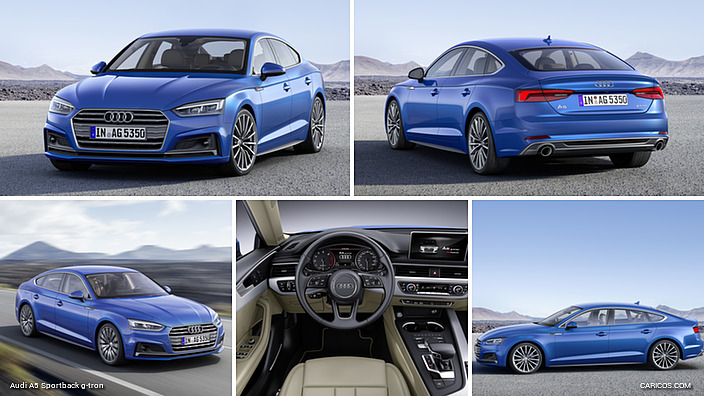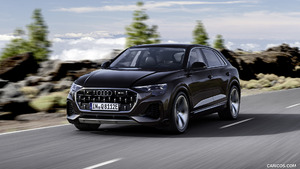2017 A5 Sportback g-tron
Audi is further expanding its g-tron fleet. The Audi A5 Sportback g-tron*, alongside the A3 Sportback g-tron* and the A4 Avant g-tron*, is now the third model that customers can run on a choice of climate-friendly Audi e‑gas, natural gas (CNG) or gasoline.
The A5 g-tron is powered by a 2.0 TFSI engine. It develops 125 kW (170 hp) of power and 270 Nm (199.1 lb-ft) of torque. With CO2 emissions of just 100 grams per kilometer (160.9 g/mi) (with S tronic), Audi is the first premium manufacturer to offer a gasoline engine in the B segment that achieves lower emissions than a comparable diesel engine.
The newly developed engine is based on the gasoline-powered 2.0 TFSI: Here, too, the innovative combustion process is used. It features a shortened compression stroke and a long power stroke as well as an increased compression ratio that has been specially designed for part load operation, by far the most common operating mode. The intake valves close much sooner than usual. In combination with increased pressure in the intake manifold, this reduces throttle losses during intake.
The tanks for the gas fuel in the A5 Sportback g-tron are located beneath the rearward structure. They store 19 kilograms (41.9 lb) of gas at a pressure of 200 bar and are of an extra-lightweight design. The inner layer consists of a gas-impermeable polyamide matrix, while a second composite layer of carbon fiber reinforced polymer (CFRP) and glass fiber reinforced polymer (GFRP) gives the tank its extremely high strength. The third glass fiber layer helps to visualize any external effects. Epoxy resin is used to bind the fiber reinforced materials.
 2017 Audi A5 Sportback g-tron
2017 Audi A5 Sportback g-tron
In the standard driving cycle the A5 Sportback g-tron uses less than four kilograms (8.8 lb) of gas per 100 kilometers (62.1 miles). So the customer benefits from extremely low fuel costs. In the NEDC cycle, the bivalent g-tron model running on natural gas covers up to 500 kilometers (310.7 miles). When the pressure in the tank falls below 10 bar with about 0.6 kilogram (1.3 lb) of gas remaining, the engine management automatically switches to gasoline operation. This makes an extra range of 450 kilometers (279.6 miles) available.
The drive unit’s high efficiency means low costs of ownership: Compared with an equivalent gasoline engine, fuel costs are markedly lower, and the reduced CO2 emissions place the vehicle in a more attractive tax bracket. The new Audi A5 Sportback g-tron is not only remarkably economical to run, it is also exceptionally clean. Nor does driving enjoyment draw the short straw. In conjunction with the S tronic transmission, the A5 Sportback g-tron accelerates from a standstill to 100 km/h (62.1 mph) in just 8.5 seconds.
The A5 Sportback g-tron is especially eco-friendly when running on Audi e‑gas. This is a first for virtually CO2-neutral long-distance mobility. Audi produces the fuel at several power-to-gas facilities using renewable energy, water and CO2. This method enables the brand with the four rings to transform surplus renewable energy into a storable product.
At the same time, Audi is determinedly continuing its research into e-fuels. Together with venture partners, the company has now come up with a new method of producing e-gas. This will assure future supplies for the growing number of g-tron models in circulation. In the new technique, Audi e-gas is obtained by biological methanation involving microorganisms. Compared with the previous chemical process, the gas is now produced at a much lower ambient pressure and at lower temperatures.









